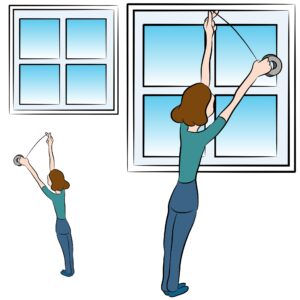Not everyone has the luxury of upgrading old windows or doing a full renovation of their existing home. Winter soon reveals how comfortable your home is…..or not!
With increasing energy costs, you soon realise how expensive your winter heating costs are.
Here are a few, inexpensive tips to make your home more comfortable in the short term before the renovations start.
Older homes can be very draughty. You can check this with the use of a candle. Check areas under and around doors and windows. You will be surprised as to how much outside cold air is entering your home.
Caulk around existing windows.
Use a caulking gun or weather strips to seal around your windows.
Replace window seals.
Some older aluminium windows may have worn seals. This may not be a DIY repair job. You may have to call in local window manufacturer or glazier.
Fit weather seals to doors.
Weather seals for doors are inexpensive but very efficient. Your local hardware store has a great range for all applications.
Block up unused chimneys.
Most older homes have fireplaces and more often than not they are not used. If this is the case consider blocking up the chimney to stop air movement.
Seal gaps in floors.
Same as for windows and doors, gaps in floors can cause an excessive amount of draught.
Insulate ceilings.
As you would be aware, hot air rises. For un-insulated homes the majority of heat loss is through the ceiling. The easiest area to place insulation is in the ceiling space due to most roof spaces providing enough room to ‘retro fit’ bulk insulation. Aim for a minimum of R3.5 insulation. More is better.
Heat transfer units.
These are relatively inexpensive and very efficient. As hot air rises and accumulates along an insulated ceiling ‘hot spots’ can occur where there is a condensed amount of hot air in one spot under the ceiling. With this area located, an outlet is positioned and the hot air is ducted to another part of the home. A small fan is used to move the air and pump it into another space. This space may be down the passage towards the bedrooms or into another room. There are suppliers on this website who can help you with the right product.
Air movement.
For larger rooms with high ceilings a ceiling fan is a great way to move that trapped hotter air back down and circulating around.
Use the sun.
Even though it’s winter and it’s cold outdoors, if the sun is shining you can harness the heat it produces. The sun sits lower in the sky this time of year and it’s not as intense however by opening up the curtains and letting the sun shine in you’ll be surprised how much heat is generated.
Good quality curtains.
When the sun disappears, close the curtains to trap the heat in your home. Full height thermal-lined curtains and pelmets along the top of windows provide the best solution.
Heat smaller spaces.
It’s easier and cheaper to keep a smaller space warm than trying to heat the whole house. Keep doors and windows closed. Shut off unused rooms and close doors behind you.
None of these tips are ‘rocket science’ but common sense solutions when on a budget.
When building new or renovating, these principles still apply. Now you can have the choice of better and more thorough insulation, new windows and glazing, efficient heating solutions and all the expert advice found here to guide you through.
Darryn White.

Nice post. I really need efficient heating solutions for my house. Glad to have your expert advice to follow.
I’ve been getting really cold at night lately. I didn’t know that you could insulate the ceiling! That seems like a great way to control the temperature, especially when you consider the fact that hot air rises. Thanks for sharing!